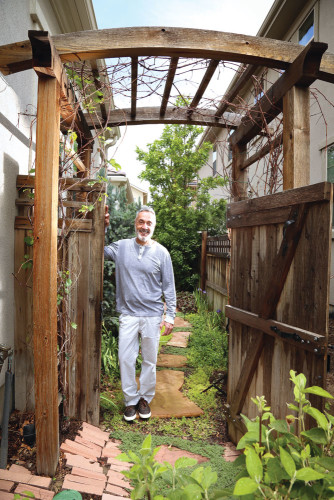
Richard Patterson stands at the entry to his garden.
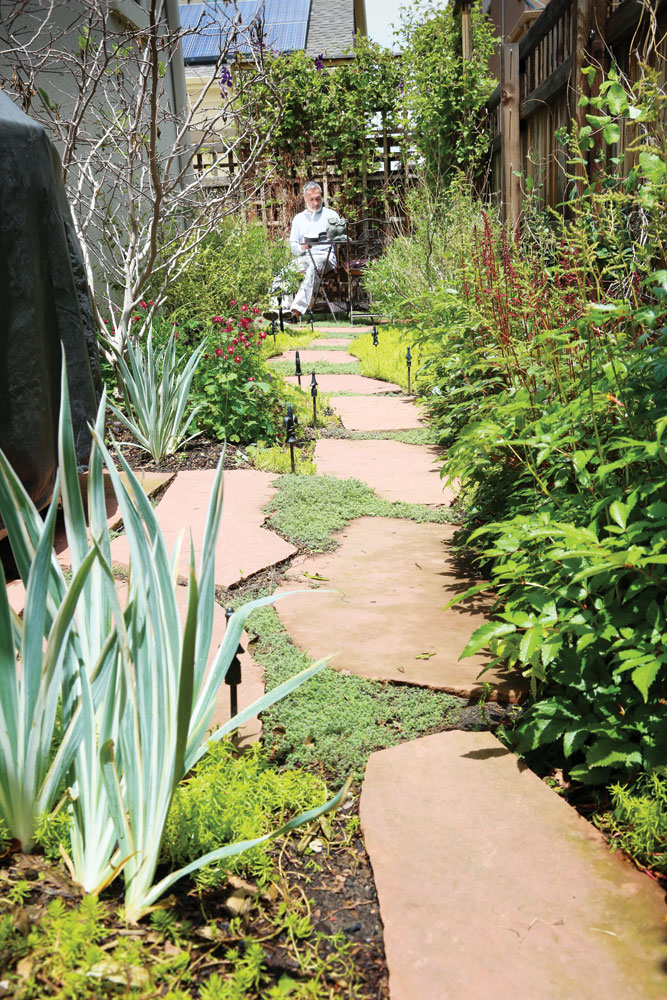
Plants include hollies, oaks, columbine, daylilies, magnolias, lilacs, iris, clematis, ferns, coral bells and wooly thyme for a carpet between the stones.
Need to get away from it all? Maybe you needn’t go any farther than your own backyard.
Richard Patterson turned an 8-foot strip between the wall of his house and the fence into a grand entry to his favorite backyard spot. David and Marilyn Jensen transformed their 26-by-58-foot backyard into a mountain stream environment. Both created private outdoor spaces that help them connect with nature.
Patterson, a middle school principal, says he rests in the garden to lose the demands of a busy life. “My work days are long and very draining—emotionally, physically and mentally. When I’m home I want privacy and green, to turn it all off.”
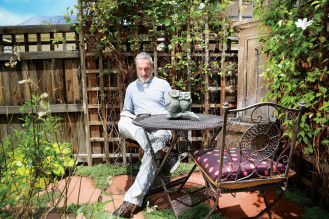
Richard Patterson sits in his “secret garden” where he gets away from the stresses of his job.
Patterson’s creation is a 45-foot-long path lined with trees and flowers. “The path is a place to walk where different flowers bloom in succession, with large enough trees to block the neighbors’ view. It meanders to my secret garden with a fountain, where I sit and drink tea, coffee or wine.”
He designed the garden with the help of a landscape architect. “We incorporated the plants I love. I wanted a great variety of colors and textures. It’s well-planned but it appears natural.”
In front of his house, Patterson planted Bosnian pines and columnar oaks. “From the house you see only trees. It cocoons you from the close proximity of neighbors.”
David Jensen, a golf course communities planner with his wife, Marilyn, said they planned their yard to create several small spaces for seating.“We wanted ‘nooks and crannies’ to sit and think about things, or read, with the stream chuckling and the pattering of a waterfall. It’s a background sound that is soothing.”
The Jensens used native Colorado plants. “In choosing the mountain meadow concept, we were able to use indigenous plants to screen us from the surrounding environment and provide variety,” said David Jensen. The Jensens’ “mountain stream” re-circulates 800 to 1,000 gallons of water. “We don’t use any toxic chemicals to keep it clean; instead, we use a beneficial bacteria product to add oxygen and digest the detritus,” Jensen said. “We are responsible to the smallest insects, which can pass toxins up the food chain. Birds, squirrels and dogs can safely drink the water.”

David and Marilyn Jensen sit in the large covered patio where they entertain. They also have a smaller table and sitting area right by their back door.
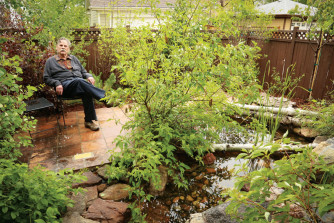
The Jensens’ mountain stream is bordered by nearly all indigenous plants, including native alder, aspens, dogwood, alpine willow and river birch. They also have columbines, ferns, service berry, raspberry, arrowroot plants and cattails. The moneywort ground cover is not native.
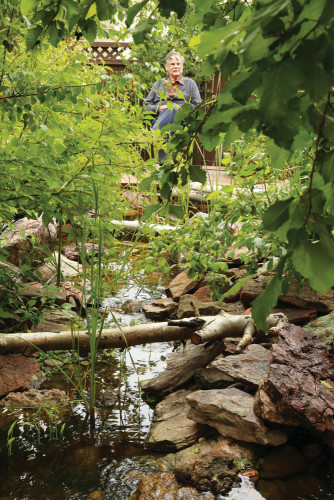
David Jensen sits in one of the “nooks and crannies” they created “to sit and think about things, or read, with the stream chuckling and the pattering of a waterfall.”
Both Patterson and the Jensens moved to Stapleton from homes with big yards. “The upkeep was continuous and it demanded time,” said Patterson. “Here I get to take care of nature in a space that is just right.”
Advantages of a small yard include cost savings, Jensen said. “Fewer plants are required, and less water. A smaller budget goes farther and less vegetation fills the area faster to create interesting views and spaces. It’s also more intimate.”
The Jensens were among Stapleton’s first residents, arriving in 2005. Patterson has been in his current house since 2009. Both said it took about five years for their gardens to fill in and become lush.
Jensen and Patterson offered some bits of advice for people thinking of transforming their yards. “Have a vision for the use of your space and start from there,” said Patterson. “What do you want the space to be? It’s not just plants; it’s part of your house. What extension of yourself will you use the space for? Also, when you have a narrow space, keep things in columnar fashion, so they grow tall and not wide. Finally, phase your plan because landscaping can be expensive.”
Jensen said, “There are many solutions for a small garden, like a strip of raked gravel, buffalo grass, a composition of groundcovers or a bed of flowers. You could have a pond with a bubbler to get that murmuring water sound.”
Jensen appreciates the ever-changing landscape. “In the garden, something is changing every day and the views are different, from the columbines blooming to catkins appearing on the aspens. It keeps me watching.”


0 Comments